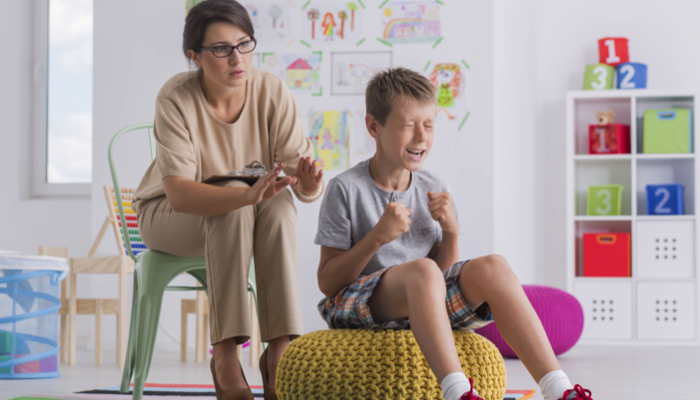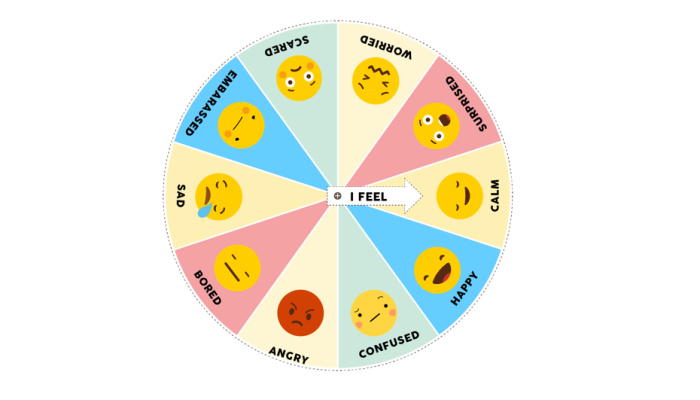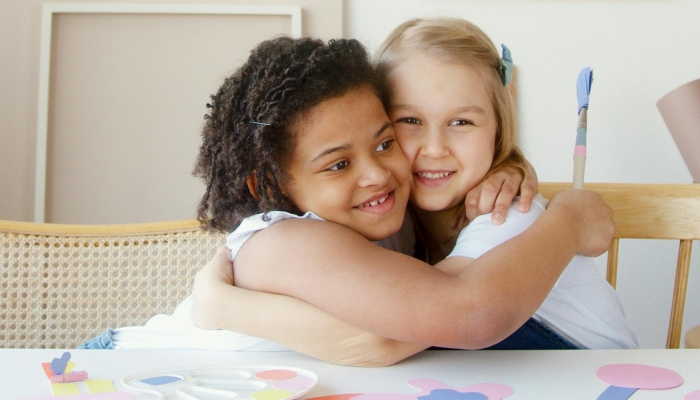5 Ways to Use a Feelings Wheel for Kids

- A feelings wheel is a visual aid that helps children identify and label their emotions in an engaging format.
- Feelings wheels can help encourage empathy as kids learn to recognize and understand the emotions of others.
- Children can work on expanding their vocabulary while articulating their feelings better using a feelings wheel.
If you’ve ever tried reasoning with a child when they’re upset, you know how challenging it can be. I have three kids, and each one handles their emotions differently, so I find that it’s valuable to use a feelings wheel to help them express their feelings.
Using a feelings wheel helps kids articulate their feelings, leading to better communication with their parents and other adults.

As with everything, you may not see success the first time you use a feelings wheel; your child may hesitate to do something new. However, consistency pays off over time, and you’ll likely notice your child beginning to communicate more efficiently and articulately.
Let’s look at five ways to use a feelings wheel for kids.
1. Identify Emotions

Young children frequently struggle to express their feelings because they lack the vocabulary. A visual aid helps break down complex emotions into simpler terms, allowing kids to pinpoint exactly how they feel at a given moment.
For example, a child might start by saying they feel “sad” and use the wheel to narrow it down to “disappointed” or “lonely.” This process helps build the foundation for emotional intelligence, helping kids to understand and articulate their feelings more effectively.
A feelings wheel can introduce them to many emotions, including:
- Anger
- Sadness
- Surprise
- Happiness
- Disgust
- Pride
2. Recognize Emotional Patterns

Another excellent way to use feelings wheels is to track emotions over time and recognize patterns. You can also start the day with a morning check-in to acknowledge feelings, which can set a positive tone and help kids become more aware of their emotional state.
In addition, a feelings wheel can help children identify and label their emotions more accurately, allowing them (or you) to notice how certain situations or interactions trigger specific feelings. While a strong-willed child can be challenging, understanding what triggers them can help both of you understand their emotional patterns.
Eventually, this practice helps them discern patterns in their emotional reactions—such as feeling anxious before a test or happy after spending time with friends. When children recognize these patterns, it helps enhance their self-awareness and equips them to anticipate and manage their emotions more effectively.
Finally, understanding these patterns can help children communicate their feelings more clearly to others, leading to healthier relationships and better emotional regulation.
3. Develop Empathy

Research shows that empathy generally emerges11. Decety, J.. The Neurodevelopment of Empathy in Humans. Developmental Neuroscience. 2010;32(4), 257-267. https://doi.org/10.1159/000317771 in social interaction when a child is two or three years old.
You can use a feelings wheel to help your child develop empathy and better understand others’ emotions. You can also use stories or activities that encourage children to connect their feelings with those of peers or characters in books.
For example, if your child notices an upset friend, they can refer to their feelings wheel to help empathize by identifying the emotion. Children can develop a deeper understanding and compassion for others when they recognize their feelings.
4. Create Self-Awareness
A feelings wheel is fantastic at helping children develop self-awareness, which they’ll develop as they better understand their feelings. For example, if your child struggles at school, they can use the feelings wheel to better understand why they feel a certain way.
Remember, you may have to guide them as they learn to navigate the feelings wheel and understand the meanings of the various emotions. A feelings wheel helps with those “big feelings” that are frequently hard to put into words.
PBS.org22. Public Broadcasting Service. Emotions & self-awareness: Self-awareness at age 8. PBS. 2010. https://www.pbs.org/parents/learn-grow/age-8/emotions-self-awareness/self-awareness has the following ways to help encourage self-awareness:
- Teach “I” statements to help children understand the cause-and-effect relationship between external experiences and their emotions.
- Introduce and normalize complex emotions to help build your child’s emotional vocabulary.
Teaching self-awareness also helps kids understand that they can feel conflicting emotions about a situation. Sometimes, knowing that it’s OK to feel happy and sad simultaneously can make those feelings less overwhelming.
5. Conflict Resolution

Emotional outbursts and conflicts are common in childhood, and children frequently have difficulty expressing their feelings during conflict. A feelings wheel can be a valuable tool in helping kids articulate their emotions during these moments, leading to more constructive resolutions.
For example, a child can use the wheel to express if they feel angry, hurt, or misunderstood, which can reduce misunderstandings while fostering a more empathetic dialogue.
In addition, if your child won’t listen or struggles to manage difficult emotions, you can use a feelings wheel along with specific strategies to help negative emotions, such as:
- Deep breathing
- Counting
- Discussing feelings
As a bonus, the feelings wheel empowers your child to navigate conflicts with greater emotional intelligence.
Examples of Feelings Wheels for Kids
While there are many feelings wheels on the internet, these are a few of my favorites:
- Mentally Healthy Schools Emotion Wheel 33. Emotion wheel for children. Anna Freud Mentally Healthy Schools. https://www.mentallyhealthyschools.org.uk/resources/emotion-wheel-for-children
- Therapist Aid Wheel of Emotions 44. Wheel of Emotions (Children). Therapist Aid. 2016. https://www.therapistaid.com/therapy-worksheet/wheel-of-emotions-children
- Mindful Coaching Tools Feeling Wheel 55. FDA. Should You Put Sunscreen on Infants? Not Usually. U.S. Food and Drug Administration. 2024. https://www.fda.gov/consumers/consumer-updates/should-you-put-sunscreen-infants-not-usually
- Reward Charts 4 Kids Feelings Wheel66. Feelings Wheel. Reward Charts 4 Kids. 2023. https://www.rewardcharts4kids.com/feelings-wheel
You can also get creative and make your own, which may excite your child about using a feelings wheel.
FAQs
What are the differences between a feelings wheel and a mood meter?
A feelings wheel and a mood meter help children identify and articulate their emotions; however, they differ in purpose, application, and structure. For example, a feelings wheel is generally circular, while a mood meter is presented in grid format.
In addition, a feelings wheel categorizes emotions into broader groups, while a mood meter is divided into separate quadrants representing different types of moods.
How often should a feelings wheel be used with children to see progress in emotional intelligence?
There is no one-size-fits-all approach to the frequency of using a feelings wheel. However, consistency is vital to seeing progress in your child’s emotional intelligence.
You can practice using a feelings wheel daily as part of your conversations, including discussing the day’s highs and lows. You may adjust the frequency based on your child’s needs, especially if they struggle with the idea.
What age is appropriate to start using a feelings wheel with children?
It’s best to assess your child’s readiness with a feelings wheel, but most children can understand the basic concepts by age three or four. However, it’s essential to understand the following factors when introducing a feelings wheel to your child:
- Cognitive development
- Language skills
- Emotional maturity
- Interest and curiosity
Remember, you know your child best and can spot the readiness cues for their needs.
References
- Decety, J. (2010). The Neurodevelopment of Empathy in Humans. Developmental Neuroscience, 32(4), 257-267. https://doi.org/10.1159/000317771
- Public Broadcasting Service. (n.d.). Emotions & self-awareness: Self-awareness at age 8. PBS. https://www.pbs.org/parents/learn-grow/age-8/emotions-self-awareness/self-awareness
- Emotion wheel for children. Anna Freud Mentally Healthy Schools. (n.d.). https://www.mentallyhealthyschools.org.uk/resources/emotion-wheel-for-children
- Wheel of Emotions (Children). Therapist Aid. (2016, April 29). https://www.therapistaid.com/therapy-worksheet/wheel-of-emotions-children
- FDA. (2024, May 9). Should You Put Sunscreen on Infants? Not Usually. U.S. Food and Drug Administration. https://www.fda.gov/consumers/consumer-updates/should-you-put-sunscreen-infants-not-usually
- Feelings Wheel. Reward Charts 4 Kids. (2023, February 27). https://www.rewardcharts4kids.com/feelings-wheel

Related Posts

Behavior
Understanding Intermittent Explosive Disorder in Children
Are you worried about your child’s unexpected aggression and explosive behaviors? Learn how to support a child with intermittent explosive disorder.

Behavior
5 Emotional Regulation Activities for Kids
Want to teach your child how to regulate emotions? Here are emotional regulation activities for kids that can help!

Behavior, Special Needs
5 Tips for Dining Out with Children Who Have Sensory Sensitivities
Worried about dining out with sensory sensitivities? Try these tips for less stress and more fun the next time you take your family out to eat.